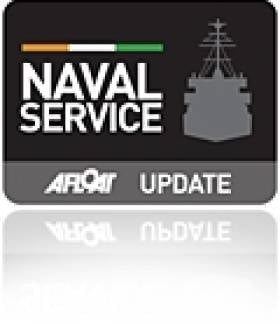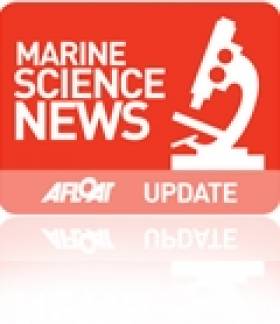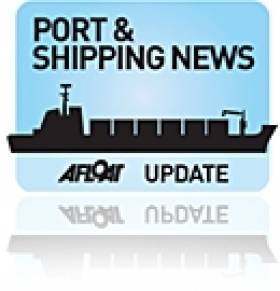Displaying items by tag: Sir John Rogersons Quay
European Naval Flotilla Docks in Dublin
Of the foursome, only ENS Tasuja is the odd one out, she is a diving and support vessel whereas the rest are all a combination of minehunters / minesweepers. ENS Tasuja is from the Lindormen-class and was built in Denmark in 1977. She is 44.5 meters long, has a maximum speed of 14 knots, and has a crew of 28.
HNoMS Maaloey is an Oksøy-class minehunter which has a catamaran hull constructed of fibre-reinforced plastic which has a very low magnetic signature. She can carry two ROV's and the same number of rigid inflatable boats (RIB).
Above: The Norwegian Navy’s catamaran minehunter HNoMS Maaloey detonates a sea-mine
She is almost identical to the Alta-class leadship HNoMS Alta which provided escort duties during the official state visit of King Harald V and Queen Sonja of Norway, on board the royal yacht K/S Norge in 2006. She arrived in Irish waters, firstly calling to Dun Laoghaire Harbour, where the royal couple boarded the royal yacht at the East Pier. From there she sailed the short distance across the bay to Dublin Port and her last Irish call was to Cork.
ORP Flaming is a mine countermeasures vessel which operates in minesweeping and minehunting. The vessel is designed to trace such devices and make safe fairways for shipping. She can detect anchored mines 1600m from the ship and bottom mines located 600m below the ship's keel. In addition she can lay mines of six different types.
FGS Überherrn is a Kulmbach Class minehunter, in service with the German Navy since commissioning in 1989. She was originally built as a Hameln Class (SM 343) minesweeper by STN Systemtechnik Nord, but was converted to the Kulmbach Class. She has an overall length of 54.4m, a width of 9.2m and a draft of 2.5m and a displacement of 635 tonnes. Armament comprises two, four-cell Stinger missile launchers firing FIM-92 Stinger surface-to-air missiles. There are a crew of 37, which includes four officers, 20 petty officers and 13 ratings.
The flotilla are moored two abreast alongside Sir John Rogersons Quay (berth No. 8), which is located on the south quays between the Samuel Beckett and East-Link Bridges. Of the four naval ships, FGS Überherrn is the first to depart on Sunday, the other vessels are to depart on Monday. The vessels will provide an opportunity to view at close quarters a variety of naval architecture design and navies from northern Europe.
It is only in recent years that larger vessels can berth at this stretch of the waterfront following the completion of several major construction projects over the last decade. From the building of the Convention Centre and the Samuel Beckett Bridge which involved using the dredger Hebble Sand (click HERE) during its construction process.
In addition the refurbishment of Spencer Dock sea-lock entrance that for many years was closed is now re-opened. The dock entrance featured in the start of the new television series 'Waterways'-The Royal Canal. Episode two is this Sunday on RTE 1 at 8.30pm.
Aside the 79m L.E. Roisin, the last large vessel to berth close to berth 16A was the French 58m tallship Belem, which was chartered by Alliance Francaise to celebrate their 50th anniversary in 2010 and for the inaugural French Hoist the Sail: Market Festival. The three-masted barque built in 1896 was once also owned by the Sir Arthur Ernest Guinness under the name of Fantôme II.
Situated between where L.E. Roisin is currently berthed and where the Belem had moored, is home to the 'resident' M.V. Cill Airne, a floating bar and restaurant dining venue at berth 16B. Another resident is the former lightship Kittiwake at berth 17B, though sited much further downstream at the end of North Wall Quay, opposite the O2 Arena and next to the East-Link Bridge.
There is a fourth resident, again berthed on the north quays, though the Jeanie Johnston unlike her counterparts is moored closer to the city-centre at Custom House Quay. Apart from yachts, leisure-craft and occasional private motor-yachts using the Dublin City Moorings, she is the only vessel to permanently occupy a berth between Samuel Beckett Bridge and the Sean O'Casey foot-bridge.
- inland waterways
- Dublin Port
- Dublin Docklands
- Royal Canal
- Jeanie Johnston
- naval service
- Custom House Quay
- Alliance Française
- Spencer Dock
- Sean O'Casey Bridge
- River Liffey
- Belem
- Sir John Rogersons Quay
- TallShips
- North Wall Quay
- Fantome II
- Dick Warner
- Dublin City Moorings
- Navy News
- O2 Arena
- EastLink bridge
- LE Roisin
- Sir Arthur Guinness
- National Convention Centre Dublin
- Samual Beckett Bridge
Taoiseach Announces Marine Jobs On Visit of RV Celtic Explorer
An Taoiseach Enda Kenny visited the Marine Institute's research vessel RV Celtic Explorer in Dublin Port today, where he announced the creation of 92 jobs in the marine sector, writes Jehan Ashmore.
"Ireland is now recognised as an emerging power in Marine Research and Innovation," said the Taoiseach. Of the new positions, 64 will be generated in the seafood processing sector. This follows a €3.5m Seafood Processing Business Investment Scheme administered by Bord Iascaigh Mhara (BIM). In the area of marine research, 28 jobs have been created through funding of €2m from an International SmartOcean Graduate Programme.
SmartOcean is a collaboration between IRCSET (Irish Research Council for Science Engineering and Technology), the Marine Institute, five Irish universities and key multinationals and SME Information and Communication Technology (ICT) companies to provide funding for 28 research posts.
The Taoiseach said: "This has been achieved through the mapping of the 90% of Irish national territory that lies under the Atlantic, the creation of a quarter of a billion Euros worth of marine research infrastructure, and the fostering of strong linkages between industry and research centres, all of which will support employment opportunities in key areas of potential growth in the marine sector."
During the tour of the RV Celtic Explorer, the Taoiseach who was accompanied by Minister for Agriculture, Marine and Food, Simon Coveney, welcomed the expansion of Ireland's capabilities in the international shipping services sector, which is expected to attract additional jobs to the country.
Ireland's emerging international shipping services sector has continued to grow, underpinned by a number of investments in new and second hand ships over the last twelve months by such companies as Arklow Shipping and the Mainport Group, as well as foreign direct investments by D'Amico and Ardmore shipping.
As reported on Afloat.ie, RV Celtic Explorer had arrived yesterday into Dublin Port, having completed a fisheries demersal survey which started in Galway on 23 September. Initially she had docked at Ocean Pier but she subsequently shifted berths to Sir John Rogersons Quay for today's reception of An Taoiseach. According to her survey schedule she is due to depart tomorrow on a herring acoustic survey which is to take place in the Celtic Sea and off the south-west coast.
- Dublin Port
- BIM
- Marine Institute
- marine science
- Arklow Shipping Ltd
- Bord Iascaigh Mhara
- Ports and Shipping News
- Ardmore Shipping
- Mainport Group
- D'Amico
- Irish marine jobs
- An Taoiseach Enda Kenny
- SmartOcean
- RV Celtic Explorer
- RV Celtic Voyager
- Sir John Rogersons Quay
- Irish research vessels
- Simon Coveney
Arthur's Day: Time to Reflect the Last Guinness Ships
The Lady Patricia represented the last of the more traditional Guinness vessels, though her predecessors The Lady Grania and The Lady Gwendolen differred in that they had split superstructures with the bridge admidships and accommodation quarters placed aft. Whereas The Lady Patricia had her superstructure positioned well aft.
In addition she was the last to carry a 'Lady' prefix name. She was named after the daughter of Lord Iveagh, Rupert Guinness, when entering service in 1962 from the yard of Charles Hill & Sons, Bristol. Her entry allowed the Guinness to be eventually replaced when she went to be scrapped at Faslane the following year.
Two deck-mounted granes that were used to hoist silver cylinders containing the beer where removed in 1973 from The Lady Patricia when she was converted into the world's first beer-tanker. The new method no longer required the cumbersome and time-consuming process of loading barrels from trucks. Instead trucks fitted with tanks transferred the liquid-cargo through pipes which involved pumped some 205,000 gallons or 1.87 million pints on board.
Unlike The Lady Patricia which was converted for tanker operations, the Miranda Guinness became the world's first custom-built beer-tanker when launched in 1976 from the Albion Shipyard also in Bristol. She also represented the last vessel to be launched (see PHOTO) there, after 156 years of shipbuilding.
Miranda Guinness was named by the Countess of Iveagh, after whom she was named. The newbuild replaced both The Lady Grania and The Lady Gwendolen which were sold. Since their launch The Lady Patricia and Miranda Guinness were registered in Liverpool until 1987 when the port of registry became Dublin. This arose following a change in the vessels management to Irish Marine Services Ltd, which was made up of former Irish Shipping Ltd management.
This arrangement only lasted to 1993 when Guinness discontinued the world's only beer-tanker shipping operation on the route linking Ireland and Britain. The process had allowed millions of pints to be served through the use of conveying the 'black-stuff' on board the dedicated beer-tankers or should that be those stout ships! Of the two vessels, the Miranda Guinness was the last to depart Dublin Port.
The ships were sold for scrapping on Merseyside and replaced in the form of 20-foot transportable tank trailers towed by trucks using Irish Sea ferry routes. Each of the silver tankers holds 10,000 gallons which is equivilant to 80,000 pints. It would take someone drinking 10 pints a day 22 years to drink it! Now that would be another challenge for the famous Guinness Book of Records!
In addition as we approach 17:59hrs, reflecting the 1759 date of the lease signing by Arthur Guinness, perhaps that minute could also be used to reflect a unique era in Irish brewing transportation methods and shipping history. By the way, Cheers to Arthur!
- River Liffey
- Ports and Shipping News
- Sir John Rogersons Quay
- Irish Shipping Ltd
- Guinness
- Guinness barges
- The Last Guinness Ships
- Arthur's Day
- The Lady Patricia
- Miranda Guinness
- Stout Ships
- Beer tankers
- Runcorn
- Manchester Ship Canal
- St. James Gate
- Stouttankers
- Charles Hiil & Sons Bristol
- Irish Marine Services Ltd
- Salford Docks
- Guinness concentrate
- Albion Shipyard Bristol
Norwegian Tallship Opens to the Public in Dublin Docklands
The arrival of the largest and oldest Norwegian tallship the barque S/S Statsraad Lehmkuhl into Dublin Port yesterday made for an impressive sight, even without her sails set, writes Jehan Ashmore.
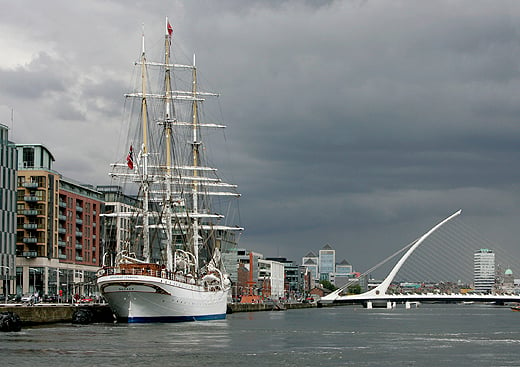


Her arrival marks nearly a year in advance to Dublin City welcoming the return of the Tall Ships Races, presented by Szczecin and organised by Sail Training International. The capital last hosted the event in 1998 and next year up to 100 tall ships are to sail into the capital which will be the final host port for four days between 23rd-26th August 2012.
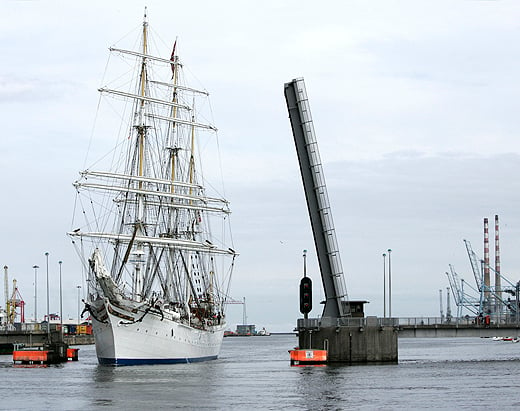
Tall Ship S/S Statsraad Lehmkuh in Dublin Bay yesterday. Images: Iain White
The celebration of sail is expected to draw entrants from as far away as Chile, Mexico, Argentina, USA and European and Baltic countries including Italy and Norway will chart their course to Dublin. It is hoped that the event will attract over a million visitors to the city, topping the 500,000 spectators who thronged the Waterford quays during this year's tall ship race gathering.
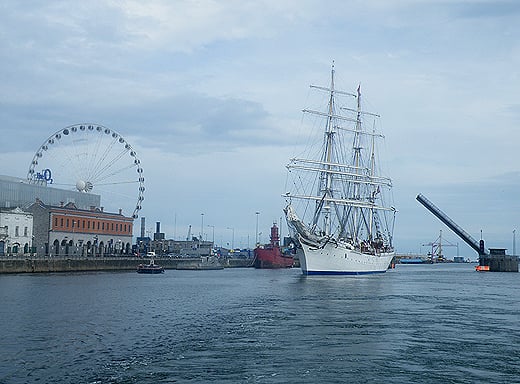
Photo: Jehan Ashmore
French Navy to Visit Dublin's St. Patrick's Festival
CMT Cassiopée is a 'Tripartite' class minehunter built for the navies of France, Belgium and The Netherlands. The class were conceived in the 1970's and built during the following decade. The French built the mine-hunting equipment, the Belgians provided the electronics and the Dutch constructed the propulsion unit.
Displacing 615 tonnes, Cassiopée (see photo) was built by the Direction des Constructions Navales (DCN) shipyard in Lorient and entered service in 1984. The 51.5m minehunter has a crew of 49. Over the years several of the Tripartite class were sold to the navies of Bulgaria, Indonesia, Latvia and Pakistan.
In January 2009 the Cassiopée was joined by the L.E. Emer (P21) in Bantry Bay to commemmorate the 30th anniversary of the Whiddy Island Oil Refinery disaster and the sinking of the French supertanker the Bételgeuse.
Like the Cassiopée the minehunter BRS Altaïr (M771) was also built in 1984 but at the Chantier (Socarenam) shipyard at Boulogne-sur-Mer. At 28m long the craft (photo) is one of the three Antar class which has a 250 tonnes displacement and a crew of 23.
The French Naval call to the capital was to coincide with a visiting task force group from the German Navy. The task force of two frigates and a support ship were due to visit at the weekend but this was cancelled due to humanitarian relief operations off Libya. To read more about this and the task force vessels click here.



























